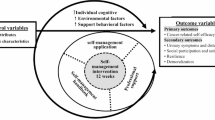Abstract
Treatment for men with lower urinary tract symptoms (LUTS) has developed into a “cascade” that escalates from watchful waiting through medical treatment to surgery. Self-management can help men to adopt lifestyle and behavioral modifications that will avoid or delay an escalation in treatment and reduce symptoms. Although many of these interventions are advised to men with LUTS, it is usually in a nonstandardized and unsystematic way. Recent work in this area has defined a self-management program for men with uncomplicated LUTS using formal methods and assessed its effectiveness in a randomized controlled trial. Self-management significantly reduced the frequency of escalation through the treatment cascade and reduced urinary symptoms (as effective as medication), suggesting that self-management could be considered as first-line treatment for men with LUTS.
Similar content being viewed by others
References and Recommended Reading
Wasson JH, Reda DJ, Bruskewitz RC, et al.: Comparison of transurethral surgery with watchful waiting for moderate symptoms of benign prostatic hyperplasia. N Engl J Med 1995, 332:75–79.
American Urological Association: Guidelines on the management of benign prostatic hyperplasia. Available at http://www.auanet.org/content/guidelines-and-quality-care/clinical-guidelines/main-reports/bph-management/preface_toc.pdf. Accessed December 2008.
Madersbacher S, Alivizatos G, Nordling J, et al.: EAU 2004 guidelines on assessment, therapy and follow-up of men with lower urinary tract symptoms suggestive of benign prostatic hyperplasia (BPH guidelines). Eur Urol 2004, 46:547–554.
Brown CT, Van der Meulen J, Mundy AR, Emberton M: Lifestyle and behavioural interventions for men on watchful waiting with uncomplicated lower urinary tract symptoms: a national multidisciplinary survey. BJU Int 2003, 92:53–57.
Brown CT, Van der Meulen J, Mundy AR, et al.: Defining the components of a self-management programme for men with uncomplicated lower urinary tract symptoms: a consensus approach. Eur Urol 2004, 46:254–263.
Drug and Therapeutics Bulletin: Managing lower urinary tract symptoms in men. Drug Ther Bull 2003, 41:18–21.
National Institute for Clinical Excellence: Referral advice: a guide to appropriate referral from general to specialist services. Available at http://www.nice.org.uk/nicemedia/pdf/Referraladvice.pdf. Accessed December 2008.
de la Rosette J, Alivizatos G, Madersbacher S, et al.: EAU guidelines on BPH. Eur Urol 2001, 256–263.
AUA Practice Guidelines Committee: AUA guideline on the management of BPH (2003). Chapter 1. Diagnosis and treatment recommendations. J Urol 2003, 170:530–547.
Newman S, Steed L, Mulligan K: Self-management interventions for chronic illness. Lancet 2004, 364:1523–1537.
Barlow J, Wright C, Sheasby J, et al.: Self-management approaches for people with chronic conditions: a review. Patient Educ Couns 2002, 48:177–187.
NHS Information Centre for Health and Social Care: Prescription cost analysis England 2007. Available at http://www.ic.nhs.uk/webfiles/publications/PCA%20publication/PCA%202007%20complete%20V2.pdf. Accessed December 2008.
Thomas AW, Cannon A, Bartlett E, et al.: The natural history of lower urinary tract dysfunction in men: minimum 10-year urodynamic follow-up of untreated bladder outlet obstruction. BJU Int 2005, 96:1301.
Barry MJ, Fowler FJ, Mulley AG, et al.: Patient reactions to a program designed to facilitate patient participation in treatment decisions for BPH. Med Care 1995, 33:771–782.
Young JM, Muscatello DJ, Ward JE: Are men with lower urinary tract symptoms at increased risk of prostate cancer? A systematic review and critique of the available evidence. BJU Int 2000, 85:1037–1048.
Brown CT, O’Flynn E, van der Meulen J, et al.: The fear of prostate cancer in men with lower urinary tract symptoms: should symptomatic men be screened? BJU Int 2003, 91:30–33.
Brown C, O’Flynn E, van der Meulen J, et al.: Towards a self-management intervention for men with LUTS. The role of caffeinated drinks [abstract]. BJU Int 2002, 90(Suppl 1):37.
Griffiths DJ, McCracken PN, Harrison GM, Gormley EA: Relationship of fluid intake to voluntary micturition and urinary incontinence in geriatric patients. Neurourol Urodyn 1993, 12:1–7.
Reynard J: Fluid balance therapy of nocturia in women. Int Urogynecol J Pelvic Floor Dysfunct 1999, 10:43–48.
Creighton M, Stanton SL: Caffeine: does it affect your bladder? Br J Urol 1990, 66:613–614.
Meigs JB, Mohr B, Barry MJ, et al.: Risk factors for clinical benign prostatic hyperplasia in a community-based population of healthy ageing men. J Clin Epidemiol 2001, 54:935–944.
Gass R: Benign prostatic hyperplasia: the opposite effects of alcohol and coffee intake. BJU Int 2002, 90:649–654.
Bryant CM, Dowell CJ, Fairbrother G: Caffeine reduction education to improve urinary symptoms. Br J Nurs 2002, 11:560–565.
Prezioso D, Catuogno C, Galassi P, et al.: Life-style in patients with LUTS suggestive of BPH. Eur Urol 2001, 40:9–12.
Reynard JM, Cannon A, Yang Q, Abrams P: A novel therapy for nocturnal polyuria: a double blind randomised trial of frusemide against placebo. Br J Urol 1998, 81:215–218.
Roberston GL, Norgaard JP: Renal regulation of urine volume: potential implications for nocturia. BJU Int 2002, 90(Suppl 3):7–10.
Donovan JL, Kay HE, Peters TJ, et al.: Using the ICSQoL to measure the impact of lower urinary tract symptoms on quality of life: the ICS-’BPH’ study. Br J Urol 1997, 80:712–721.
Paterson J, Pinnock CB, Marshall VR: Pelvic floor exercises as a treatment for post-micturition dribble. Br J Urol 1997, 79:892–897.
Abrams P, Kaplan S, De Koning, et al.: Safety and tolerability of tolterodine for the treatment of overactive bladder in men with bladder outlet obstruction. J Urol 2006, 175(3 Pt 1):999–1004.
Burgio KL: Influence of behaviour modification on overactive bladder. Urology 2002, 60(Suppl 5a):72–76.
Mattiason A, Blaakaer J, Hoye K, Wein AJ: Simplified bladder training augments the effectiveness of tolterodine in patients with an overactive bladder. BJU Int 2003, 91:54–60.
Brown CT, Yap T, Rixon L, et al.: Self-management for men with lower urinary tract symptoms: a randomised controlled trial. BMJ 2007, 334:25.
Author information
Authors and Affiliations
Corresponding author
Rights and permissions
About this article
Cite this article
Brown, C.T., Emberton, M. Self-management for men with lower urinary tract symptoms. Curr Urol Rep 10, 261–266 (2009). https://doi.org/10.1007/s11934-009-0043-6
Published:
Issue Date:
DOI: https://doi.org/10.1007/s11934-009-0043-6



